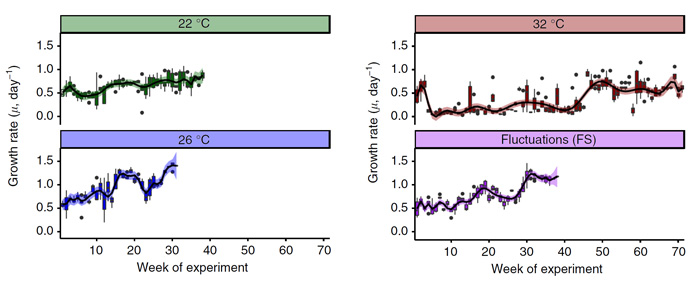| Tweet | Follow @co2science |
Paper Reviewed
Schaum, C.-E., Buckling, A., Smirnoff, N., Studholme, D.J. and Yvon-Durocher, G. 2018. Environmental fluctuations accelerate molecular evolution of thermal tolerance in a marine diatom. Nature Communications 9: 1719, DOI: 10.1038/s41467-018-03906-5.
Current models predict large declines in marine primary production throughout the 21st century if temperatures rise from global warming. However, highlighting the critical nature of their present study, Schaum et al. (2018) write that today's state-of-the-art models "do not consider the potential for marine phytoplankton to rapidly adapt to environmental changes associated with global warming," adding that "such shortcomings have unknown consequences for projected changes in global ocean primary production and arise because the mechanisms that facilitate or constrain the capacity for rapid adaptation to warming in marine phytoplankton are largely unknown" (emphasis added). Nevertheless, despite not knowing and not including the adaptation/evolution potential of phytoplankton into these models, many blindly consider the output of such models to be sufficiently accurate to be used for policy development. The recent paper of Schaum et al., however, demonstrates the absurdity of doing so.
Working with the model marine diatom Thalassiosira pseudonana, the team of five scientists assessed the potential for "mechanisms that might facilitate rapid adaptation to warming in this globally important phytoplankton." This feat was accomplished by culturing diatoms descended from a single clone in four experimental warming treatments, including (1) a control temperature treatment maintained at 22°C, (2) a moderate warming treatment maintained at 26°C, (3) a severe warming treatment maintained at 32°C, which was near the upper thermal limit of 35°C of the initial ancestor clone, and (4) a fluctuating thermal treatment where temperatures cycled between 22 and 32°C every 3-4 generations.
Results of the experiment revealed there was "an immediate and sustained increase (2.1 and 1.9-fold faster)" in growth rates observed in diatoms in the moderate warming and fluctuating temperature treatment regimes, respectively, compared to control conditions. In contrast, in the severe warming treatment, growth rate initially rose and then collapsed three weeks into the experiment, eventually recovering in a step-like fashion one year later to values that were "statistically indistinguishable from those in the control environment after 300 generations."
Commenting on these several observations, Schaum et al. say they "shed new light on the adaptive potential and evolutionary dynamics of one of the most abundant and widely distributed eukaryotic marine phytoplankton in response to warming." In this respect, they note that "evolutionary rescue under severe warming was slow (>1 year), but adaptation to more realistic warming scenarios, where temperature increases were moderate or where they fluctuated between benign and severe conditions, was rapid." In the fluctuating temperature environment, rapid adaptation of T. pseudonana was aided by what the researchers called the "temporary restoration of benign conditions [which] increased population size and therefore the probability of fixing beneficial mutations required for adaptation to the severe environment." Furthermore, they report that "consistent with this demographic effect, the lineages selected under fluctuating warming had the greatest genetic distance from the ancestor after 300 generations, indicating accelerated rates of molecular evolution." And in this regard, Schaum et al. say that "the most rapidly evolving genes were associated with transcriptional regulation, cellular responses to oxidative stress, and redox homeostasis."
But the good news does not end there. Schaum et al. also note that "because [their] experiments were initiated with a single clone, they may in fact be conservative estimates of the evolutionary potential of the highly diverse meta-population of T. pseudonana in the wild (Armbrust, 2009; Regaudie-de-Gioux and Duarte, 2010) where adaptation will also be aided by standing genetic variation." What is more, they write that their work "raises the prospect that at the physiological-level, the mechanisms underpinning rapid thermal adaptation could be universal across the broad diversity of phytoplankton." And if this latter conclusion holds true, then current predictions of the impacts of global warming on future primary production are not only off in the magnitude of change that they predict is coming, but in the very sign or direction of that change. Instead of declining, therefore, future primary production will likely increase as temperatures warm.

Figure 1. Population growth rate trajectories of T. pseudonana grown under the four temperature treatments described in the text above. Source: Schaum et al. (2018).
References
Armbrust, E.V. 2009. The life of diatoms in the world's oceans. Nature 459: 185-192.
Regaudie-de-Gioux, A. and Duarte, C.M. 2010. Compensation irradiance for planktonic community metabolism in the ocean. Global Biogeochemical Cycles 24: GB4013, doi:10.1029/2009GB003639.
Posted 21 December 2018



